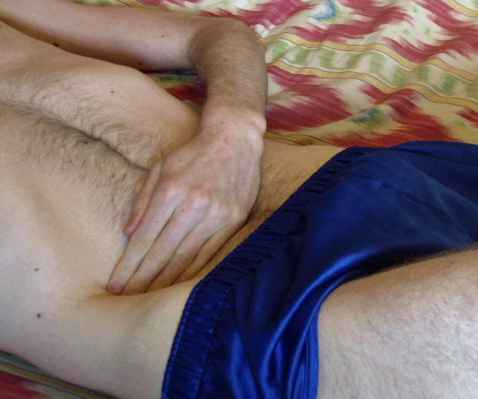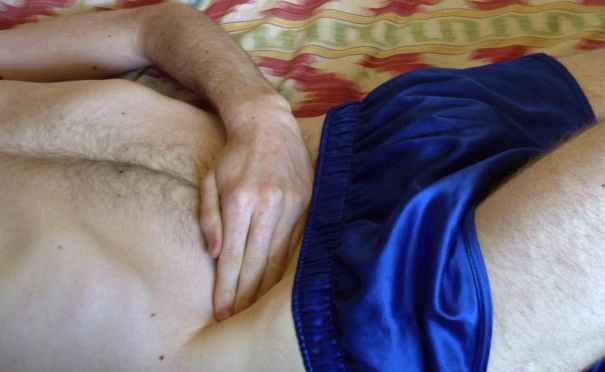DisclaimerI don't pretend to have any medical qualifications.What you do with the information on this page is your own responsibility.
What?This is a page about abdominal massage.In particular it is about massaging the ascending colon in the vicinity of the ileocecal valve. I'll start with a photograph showing what it looks like:
Why?It may not be obvious that the ascending colon needs massaging.Certanily it wasn't obvious to the author - who didn't start massaging his until his mid-twenties. However it turns out that this region is one of the most important areas of the body to massage - and manipulating it digitally is one of my top ten health tips. While the practice might not offer health benefits quite as great as some of the more major theraputic interventions - such as yoga, and calorie restriction - I nontheless regard the practice very highly.
The importance of the colonWhere does death lie in the body? It lies in the guts.This at any rate is an ancient idea - that your guts are a component more likely than most to be the source of health problems. I think the importance of a good digestive system is hard to overstate. Constapation, diarrhea, irritable bowels and fermentation within the colon are among the common problems. In more elderly patients the colon itself can become deformed - and diverticular regions can form in the colon wall, which act as seeds of inflammation and irritation.
An unnatural conspiracySeveral factors combine in human beings to make the ascending colon a problem area.An upright posture causes many of the problems. The colon is no longer haging down from the spine in the way it is in most mammals. Instead the spine is vertical - and the colon rests in the pelvic basin - with the rest of the intestines and internal organs sitting on top of it. The lack of normal support, the pressure from the abdominal organs from above and the unyielding pelvic basin below result in a lower-abdominal region that is under pressure. One more serious outcome of such pressure is a hernia - where the guts burst forwards through the abdominal wall. The human upright pose means that peristalsis has to work against gravity in order to get chyme up to the hepatic flexure. There's a "dead point" in the colon near the ileocecal valve - known as the cecum. This acts like a backwater - and is the top spot in the colon for infections, parasites and stagnant material. The appendix comes out of the cecum. It is another potential problem area and infection site. Lastly the lower abdomen of most animals is massaged automatically - by their thighs - as they walk along. Regular rhythmic disturmance is just the thing to assist peristalsis - but in humans it is almost completely absent - since during most types of locomotion the human thigh doesn't go anywhere near the colon.
TherapyThere are a range of things that can be done to improve the health of the colon. You can eat a high fibre diet. You can attemt to positively inflence your intestinal flora by avoiding consuming meat - and by ingesting "probiotics".Massage is an effective way of dealing with certain colonic difficulties. It is most effective at breaking up relatively solid fecal material - and relieving blockages.
The Second ChewAbdominal massage offers a second chance at mechanically breaking up your food.The first opportunity arises in the mouth - where you have teeth specially designed for this purpose. The second opportunity arises at the start of the ascending colon. There is a natural pause which gives time for material to collect there - and the muscles in the abdominal wall are very thin there. It is the best opportunity available for further breaking up fecal material via digital manipulation.
How?A special position is adopted.Then the ascending colon is manipulated with the digits of the hands.
Assuming the postitionThe position involves lying on ones back, lifting ones right leg and placing the right foot near the left knee. Then you press down on the right food and slightly lift the right buttock from the surface.This position's main effect is to make sure that the abdominal muscles are not extended - and to give them a reasonable chance to relax. Then you relax the muscles in your abdomen - and you keep them relaxed. This step is important - since tensed muscles will form an mechanical barrier which will prevent you from feeling what's going on and having any theraputic effect.
Digital manipulationDescribing massage techniques is never easy. I'll do my best here.Place the hands in the following position:
Then explore your ascending colon with your thumbs to see what it feels like. Feel your colon using your thumbs - and feel your thumbs using your colon. Your main aim at this point is to attempt to thoroughly liquefy any fecal material in the cecum before peristalsis grabs it and takes it out of your reach. To that end you will be attempting to squeeze material in your colon back and forth - rather as if it was toothpaste in a tube. Unfortunately the tube is not so accessible as a toothpaste tube is - so you may find the procedure more challenging. Fortunately, behind the colon there's a relatively hard surface to press against - in the form of the pelvic basin. By applying force downwards and moving the point of pressure along the colon, material within the colon can be forced around. I find the most effective way to do this is to apply force downwards, and then to move the point of pressure away from my head - thus forcing fecal matter downwards into the cecum. This might sound like the wrong thing to do. Massage schools teach to massage your colon in a clockwise direction - to give peristalsis a helping hand. However in this case, clockwise is precisely the wrong way to go - for several reasons:
You will also probably get another sort of feedback - squelching sounds. The noises made by forcing feces around in the cecum can be suprisingly loud - are very difficult to avoid. Don't expect to get the hang of it straight away. The only way to really learn what to do in this area is to explore your body, listen to what it tells you it needs, and then find a way to provide it. Inevitably this learning process takes some time. If it is any consolation, it took me some months to figure out what to do - though I was labouring under the dual disadvantage of having no guide - and no instructions. The other most common hand position I use is this one:
This only uses one hand, and applies force more gently and from a bit of a different direction. Manipulation takes place primarily with the ring and little fingers - but backed up by the rest of the hand. The index and ring finger of te right hand can join in if available. Practicing correctly will normally result in a tangible sense of released blockage and congestion.
Notes
SafetyI don't regard the practice as especially safe. It certainly has not been very well researched - and I expect that - if practiced without care - it may sometimes cause harm.There are several obvious hazzards - some obvious ones are applying excess force, and possible negative side effects associated with previously having swallowed pointy objects. Excess force localised on the ileocecal valve might have negative side effects - and increasing pressure in the cecum might force food into pockets in the colon wall - or into the appendix. I find that the colon is generally well-supplied with nerves - and provides good sensory feedback. However it may be best not to depend on the reliability of this feedback too much. I think an intelligent and cautious practice will be an effective way of avoiding these potential hazzards. However, it is up to the individual practitioner to make sure they know what they are doing.
When?Practice when your ascending colon has some food in it.That is most likely to be be early in the morning - and an hour or so after a meal. You might feel the urge to evacuate your bowels afterwards. This is a normal response.
How often?I practice this sort of massage on myself several times a day.I recommend practicing every morning upon awakening - and whenever you feel like you need it. How frequently you practice it is - of course - up to you.
Contraindications and theraputicsAs with many therapies, it seems likely that this one is contraindicated in the presence of some disorders - and especially beneficial in other ones.I know of few contraindications. Some types of colostomies - perhaps - might qualify. Cases that will benefit most are probably constipation and its relatives - the disorders of being bunged up. However many - even apparently unrelated - disorders may also benefit - because of the important role of the colon in general health.
ToolsIn addition to digital manipulation, massage tools may be employed.
Both massage rollers and vibrating devices are of some interest in this context.
HistoryI don't know how widely practiced this type of technique is.I have encountered others who practice it or have heard of the practice - but they seem to be few and far between. It is fairly clear that the yogis understood the benefits of manipulating the colon from without. Many of the traditional asanas directly affect the colon - using the heels. Consisider this quote from Light on Yoga - by B.K.S. Iyengar:
Yoga Mudrasana intensifies the peristaltic activity and pushes down the accumulated waste matter in the colon and thereby relieves constipation and increases digestive power. (p.112) Paripurna Matsyendrasana is probably the classic yoga pose that jams the heel directly deep into the abdomen. It's effects are described as follows: "It increases gastric activity, helps digest food and eliminate toxins." (p.223). However, use of the heels seems to be a relatively crude means of manipulating the colon - I believe most such manipulations are better done digitally. In modern times, Dr. Rosita Arvigo is one of the better known promoters of abdominal massage. Her web site: http://www.arvigomassage.com/. There is also a Taoist Taoist Abdominal Massage practice - known as Chi Nei Tsang. Most abdominal massage involves large clockwise movements over the whole abdomen. That sort of technique has little to do with the type of massage described here.
|




